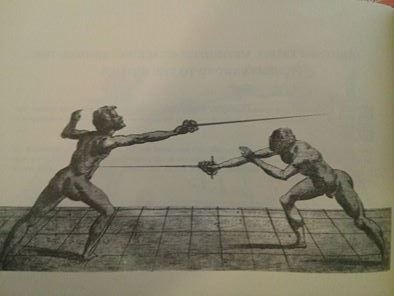Whoever wishes to be accomplished in this profession needs to understand not only how to move well, parry correctly, and control the sword. He must also understand how to evade thrusts with his body.
Giganti illustrates and explains four voids against thrusts in the Second Book (though he only calls two of them voids) and two voids against cuts (see previous discussion on defense against cuts). These, in addition to the Inquartata (aka Volte or Scanso della Vita) from the first book, encompass the defense-by-void against attacks on high and low lines, inside and outside.
The art in Giganti’s second is literally and figuratively sketchy. It’s not particularly clear, and doesn’t speak of a confident artist familiar with the human form doing the wood carvings. However, Giganti still leaves a lot of information to be inferred or learned through practice, and where the text is silent it’s worth looking to the art for evidence so long as the art is not completely at odds with his previous teachings, general physics, or human anatomy.
One of those necessary inferences is around the actual body mechanics of the void: Voids come from the hips and feet (and really, the feet just move the hips to different positions so that when you bend at the waist, either more forward or more back, it moves your upper body off-line). Three of the voids illustrated bend more forward, one bends backward. In each case, the hips and feet are moved to bring the center of mass out of the vertical plane of the opponent’s attack, and the torso leans to move the target area even further off-line while rotating the shoulders to move the sword in to close the line and point at your opponent.
Another inference is that voids are defenses used when at measure or inside measure, but considering most of Giganti’s fight begins just out of measure and concludes at measure, that’s not an unreasonable stretch.
Each begins by finding at measure, and waiting for the opponent to perform a cavazione. Against low-line attacks from the opponent, the step, of the front foot, goes to the same side as the original find (Find to inside, opponent cavaziones to the outside, you step to the inside; find to the outside, opponent cavaziones, step to the outside with the front foot – this is Capo Ferro’s Scanso del Pie Dritto). In these cases your hand is raised (with true edge toward their blade) and your point lowered to close the opponent’s line while targeting their exposed flank.
Should the opponent’s cavazione target your face, the response is to drop your head and torso out of the way (a sort of half passata soto) and extend in a low terza. Though it’s not described in the text, the art indicates a step is included: either the back foot to the inside and backward when starting with the find on the inside, or the front foot out to the side when starting with the find on the outside (as above, the step is to the side of the original find). In both cases, the follow-on is to put your left hand on the hilt of his sword (probably assisted by a passing step) and stab him a few more times, because this is Giganti after all.
The play wherein you find to the outside and your opponent performs a cavazione to your face in quarta is titled “The True Method of Defending Against an Inquartata with a Void of the Body”. While the art does not show the full girata that Lo Schermo does, the opponent is in a position that could be a slight lunge to the inside (fully in keeping with Giganti’s system) or a slight girata. Which means that voids are the counter to voids.

Leave a Reply